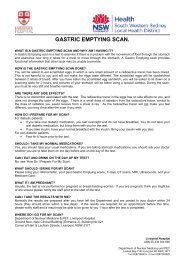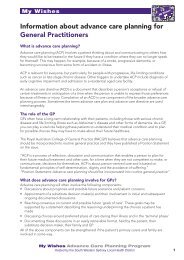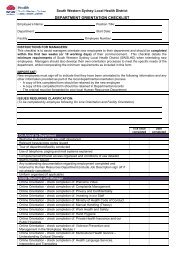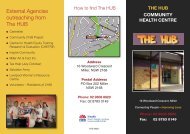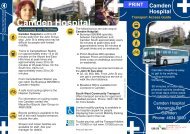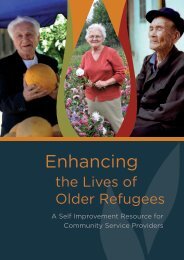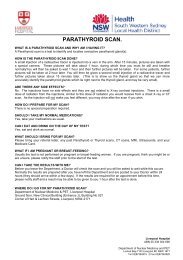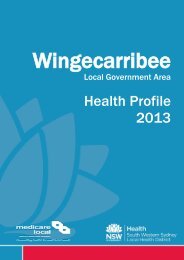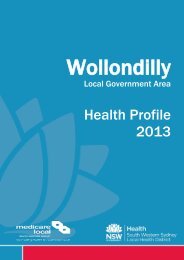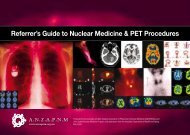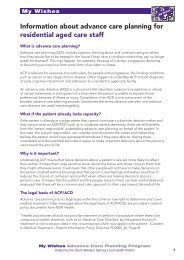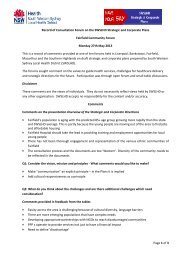Nuclear Medicine Therapy Guide
Nuclear Medicine Therapy Guide
Nuclear Medicine Therapy Guide
Create successful ePaper yourself
Turn your PDF publications into a flip-book with our unique Google optimized e-Paper software.
• To treat joint pain and some types of arthritis,<br />
the radiopharmaceutical is injected into the joint<br />
fluid under local anaesthetic. Afterwards, the<br />
joint will be immobilised with a bandage and<br />
light splint. Patients may go home to rest but<br />
are sometimes asked to stay in hospital for a<br />
short time.<br />
• To relieve the pain from cancer that has spread<br />
to bone, the radiopharmaceutical is injected into<br />
a vein in the arm. This feels like having a blood<br />
test. Patients are usually treated as outpatients<br />
and do not need to stay in hospital. The pain<br />
may increase for a short time up to 10 days<br />
after treatment. This is managed by increasing<br />
painkillers until the pain decreases.<br />
Pain relief usually lasts for up to six months. If the<br />
pain comes back, the treatment may be repeated.<br />
What safety measures should I take after<br />
nuclear medicine therapy?<br />
The simple safety measures you should take and for<br />
how long depend on the type of therapy you have.<br />
Some of the safety measures you may need to take<br />
- for as little as 24 hours to as long as 10 days - are<br />
briefly described below.<br />
• Most of the radiopharmaceutical leaves the body<br />
in urine so it is important to have good toilet<br />
hygiene.<br />
– Wipe up any spilled urine with toilet paper<br />
and put the toilet paper in the toilet.<br />
– Flush the toilet twice after each use and<br />
wash your hands well after using the toilet.<br />
– Males should use a normal toilet rather than<br />
a urinal.<br />
• Limit the time spent in close contact with people.<br />
– Avoid contact with pregnant women and<br />
small children.<br />
– A good guide is to stay more than one arm’s<br />
length away from people.<br />
– Sleep in a single bed if possible.<br />
– Avoid unnecessary trips on public transport<br />
and attending public entertainment. You<br />
could be sitting next to a pregnant woman.<br />
– Do not go to work if this involves prolonged<br />
contact with people.<br />
• Wash your hands well before preparing food and<br />
use single-use disposable gloves during food<br />
preparation.<br />
• Use disposable eating utensils or wash your<br />
utensils separately.<br />
• Wash any bed linen, towels or clothes that are<br />
soiled with urine or blood at once and separately.<br />
Wash your bed linen, towels and clothes at home,<br />
separately. No special cleaning of the washing<br />
machine is needed between loads.<br />
Before you leave, the nuclear medicine staff<br />
will explain in more detail the safety measures<br />
needed for the sort of therapy you are to have and<br />
for how long after the therapy you need to take<br />
special precautions.<br />
Are there any side effects?<br />
Side-effects can occur after nuclear medicine<br />
therapy. Usually these are minor. Your doctor will<br />
discuss in detail what other complications could<br />
occur in your case and explain things you can do to<br />
reduce or avoid side effects.<br />
The nuclear medicine staff will be happy to<br />
answer your questions before or during your<br />
treatment, or after you have gone home.<br />
If you would like more detailed information<br />
on your treatment, please talk to your doctor<br />
or nuclear medicine specialist.<br />
Produced by the Australian and New Zealand Association of Physicians in <strong>Nuclear</strong> <strong>Medicine</strong> (ANZAPNM) as part<br />
of its Quality <strong>Nuclear</strong> <strong>Medicine</strong> Program, with assistance from the Australian Department of Health and Ageing.<br />
May 2009



